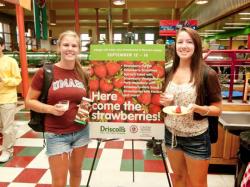UMass Dining & Driscoll's Team Up To The Delight Of Students
November 2, 2011 | 2 min to read

Watsonville, CA – Students at the University of Massachusetts/Amherst campus enjoyed a surprise on their return in the Fall with flavor-focused berry dishes when UMass Dining and Driscoll’s teamed up for the week-long “Here Come the Strawberries” promotion. The promotion ran September 12-16, 2011, campus-wide in all four dining facilities, seven cafes, and three retail store venues.
The UMass Dining staff, under the direction of Ken Toong, executive director of auxiliary enterprises, let nature take the lead and created tempting dishes centered on Driscoll’s strawberries, with some also featuring Driscoll’s Raspberries. Over 20,000 students, faculty and staff enjoyed healthful dishes such as: Strawberry Parfaits, Strawberry Smoothies, Spinach Salad with Strawberries and Raspberries, Pork Medallions with Strawberry-Herb Sauce, and of course, the highly interactive and popular fondue station.
With Driscoll’s support, UMass Dining promoted the specialty menu in the dining halls on posters, on the website, and on the school radio station. According to Martha Monaghan, Special Events Manager, “Our goal was to offer as many fresh, healthy options as possible to our customers and they really did
appreciate this one! The support from Driscoll’s made a huge difference.”
Driscoll’s Foodservice Sales Manager, Randy Benko, commented, “The UMass and Driscoll’s partnership was really a team effort between our sales team, distributor partners and the UMass culinary team. We were excited to see the bump in berry usage at UMass, while at the same time our brand gained visibility among college students, one of our strongest foodservice segments.”
UMass Dining Services is one of the largest college dining programs in the country with more than $70 million in annual revenues.
Driscoll’s is the world’s leading brand of fresh conventional and organic berries. For four generations and over 100 years, the Driscoll’s brand has been trusted and recognized for its superior quality. To fulfill their mission to continually delight berry consumers, Driscoll’s naturally breeds proprietary plant varieties that produce ONLY THE FINEST BERRIES® year ‘round. Visit www.driscolls/foodservice.com for foodservice-specific menu ideas and product information.
Source: Driscoll's
